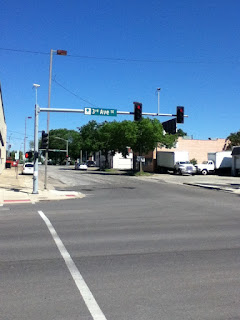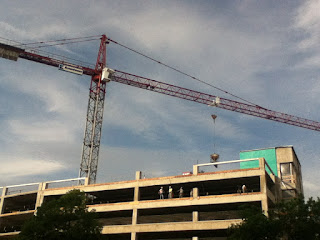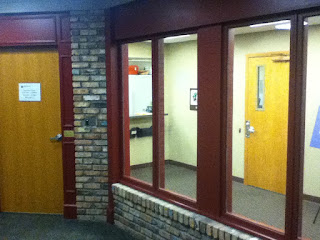The University of Iowa Public Policy Center held an excellent symposium in Cedar Rapids today, examining progress and future policy challenges five years after Cedar Rapids's historic flood. The symposium was held at the National Czech and Slovak Museum and Library south of downtown; the museum has been moved to higher ground since 2008, having been worked over quite destructively by the flood waters. Meanwhile, record spring rains have brought the river to the brink of flooding again. [Here's my wife Jane's report on the situation as of this afternoon.)
Any number of commenters find this ironic; I would say it was going to happen sooner or later, and probably introduced a sobering element to the discussions.
There were four panels, a keynote speech and a delicious lunch. The panels started with science, and moved gradually towards a focus on public policy.
A lot of the policy discussions dealt with the need to change agricultural practices, with not as much as I'd expected on development in Cedar Rapids. However, Joe O'Hern, Cedar Rapids's executive administrator for development services, received a few pointed questions from the audience.
O'Hern's panel also included Kamyar Enshayan, director of the Center for Energy & Environmental Education at the University of Northern Iowa. Enshayan argued that policy makers are ignoring clear mathematical, scientific and engineering data that bear on future flooding. Three specific lessons which have not led to policy response are:
- Flood plains are important, and shouldn't be built upon. He didn't call out Cedar Rapids, but did mention Cedar Falls and Iowa City as the only Iowa municipalities that have restricted development in the 100-year flood plain.
- Diverse cropping systems are better than the continuous corn or corn-and-soybean planting that dominates Iowa agriculture. This is driven by perverse incentives in the federal commodity support program.
- Burning fossil fuel is destabilizing our climate.
Cedar Rapids is, of course, rebuilding downtown, which is within half a mile of the river. Earlier, city manager Jeff Pomeranz congratulated the city on retaining 82 percent of the businesses that were flooded, and this blog has already testified to the vigorous reconstruction activity going on. The trendy New Bohemia area is also right by the river, and while we were discussing various New Bo businesses were being sandbagged against the coming deluge.
Enshayan didn't challenge Cedar Rapids's development choices, but two or three members of the audience did. In response, O'Hern pointed out that downtown is where downtown is, that there's "an existing huge investment in the 500-year flood plain," and that this remains the core of the city. We can't, he said, pick it up and move it. He also said the since the flood the city has opened up over 200 acres of green space along the river.
I'm with O'Hern on this. In an earlier post I imagined an urban zone from Wellington Heights in the east across the river to the Taylor Area in the west (and, why not, extending south to New Bohemia). This is, of course, dependent on proper development of the Medical Quarter. To the extent that the city can become more compact, it will address some of the fossil fuel problem that Enshayan also cited. For civic reasons it matters very much that city hall is downtown (which it once more is, in a former federal courthouse next to the river) as opposed to River Ridge or Westdale Mall. But the nagging question remains: if we redevelop this area, are we asking for trouble?
[The equation changes in favor of urban redevelopment if Cedar Rapids gets better flood protection. Pomeranz mentioned this as an ongoing need, and State Senator Rob Hogg returned to this theme several times. "Don't gush too much over Cedar Rapids," he cautioned a fellow panelist. "We have a long way to go." But since 2008, two flood protection referenda have been rejected by Cedar Rapids voters.]










































